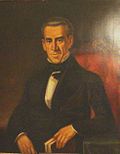| |||||||||||||||||
| |||||||||||||||||
 County results Clay: 50–60% 60–70% 70–80% 80–90% >90% Parsons: 50-60% 60-70% 70-80% Unknown/No Vote: | |||||||||||||||||
| |||||||||||||||||
| Elections in Alabama |
|---|
 |
The 1835 Alabama gubernatorial election was an election held on August 3, 1835, to elect the governor of Alabama. Democratic candidate Clement Comer Clay beat Whig candidate Enoch Parsons with 65.44% of the vote.

